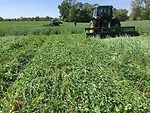Items Tagged with 'improve soil health'
ARTICLES
Purdue Ag Economy Barometer Finds That Most Growers Still New to Using Cover Crops
Out of 400 large-acreage growers surveyed, 41% are currently seeding covers on their operations.
Read More




